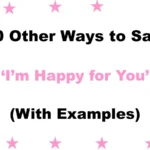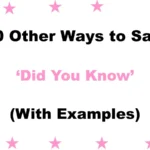Finding the right words to communicate clearly and kindly is essential, especially when sharing important documents or files. The phrase “Please see attached” is commonly used, but sometimes it can feel a bit routine or impersonal. Using thoughtful alternatives can help your message sound more warm, caring, and engaging, making the recipient feel valued.
Whether you’re emailing a colleague, client, or friend, choosing the best phrasing can improve the tone and clarity of your communication. This article shares 30 meaningful ways to say “Please see attached”, complete with definitions, examples, and tips on when to use each phrase effectively.
What Does “Please See Attached” Mean?
“Please see attached“ is a brief, professional phrase used in emails to let the recipient know that a file or document has been included as an attachment. It’s often used to direct someone’s attention to important materials like reports, forms, or images. While concise, it can sometimes feel formal or impersonal. Using a more personalised version can make your message warmer and more engaging.
When to Use “Please See Attached”
Use “Please see attached” when you’re including a file, document, or image with your email or message. It’s commonly used in professional or formal settings to politely direct the recipient’s attention to an attachment. This phrase works best when you’re sending resumes, reports, invoices, or any important materials. Keep it clear and concise to maintain a respectful tone.
Is It Professional/Polite to Say “Please See Attached”?
Yes, saying “Please see attached” is generally considered professional and polite, especially in formal emails. However, it can sometimes feel a bit terse or impersonal on its own. To soften the tone, you might say, “Please see the attached file for your reference,” or “I’ve attached [document name] for your review.” Adding a brief description or context helps make the message feel warmer and clearer.
Pros and Cons of Using “Please See Attached”
Pros:
- Clear and direct
- Professional and universally understood
- Suitable for formal and informal communication
Cons:
- Can sound repetitive or mechanical if overused
- May feel impersonal without additional context or warmth
Synonyms for “Please See Attached”
- Kindly find the attached
- Attached is
- Please find the attachment
- Enclosed is
- I’ve attached
- Here is the attached
- The attached document contains
- Attached please find
- You will find attached
- Please take a look at the attached
- The file attached includes
- Refer to the attached
- See the attached document
- The attachment contains
- I am sending you the attached
- Enclosed you will find
- Please review the attached
- Attached for your reference
- I have enclosed
- Attached herewith
- Attached for your review
- The attached file is
- Please examine the attached
- You may refer to the attached
- Please check the attached
- Find the attached document
- I’m sharing the attached
- Please see the enclosed
- The attachment provided
- The attached file includes
1. Kindly find the attached
Definition: A polite way to direct the recipient to the attached file.
Detailed Explanation: This phrase adds a gentle, courteous tone by using “kindly,” making it more warm and respectful than a simple directive.
Scenario Example: In a business email, you write: “Kindly find the attached report for your review.”
Best Use: Formal or semi-formal professional emails where politeness is key.
Worst Use: Might sound overly formal in casual communication.
Tone: Polite, respectful, and courteous
2. Attached is
Definition: A straightforward, clear phrase indicating what is attached.
Detailed Explanation: This is direct and efficient, often followed by a brief description of the attachment.
Scenario Example: “Attached is the invoice you requested.”
Best Use: When you want to be concise and to the point.
Worst Use: Can feel abrupt if not softened with a friendly opener.
Tone: Direct, professional, and concise
3. Please find the attachment
Definition: A classic phrase that politely points out the attachment.
Detailed Explanation: It’s widely used in professional settings and understood clearly by recipients.
Scenario Example: “Please find the attachment containing the meeting agenda.”
Best Use: Formal or professional emails.
Worst Use: Can feel repetitive or formal in casual emails.
Tone: Formal, polite, and standard
4. Enclosed is
Definition: A formal way to indicate something is included with the message.
Detailed Explanation: More common in printed letters but also used in emails to add a traditional, respectful tone.
Scenario Example: “Enclosed is the signed contract for your records.”
Best Use: Legal, official, or formal business communication.
Worst Use: Might sound outdated in informal contexts.
Tone: Formal, respectful, and traditional
5. I’ve attached
Definition: Casual and personal way to indicate you have included a file.
Detailed Explanation: This phrasing feels conversational and friendly, suitable for closer colleagues or clients.
Scenario Example: “I’ve attached the draft for your feedback.”
Best Use: Informal or semi-formal emails within familiar networks.
Worst Use: Too casual for very formal communications.
Tone: Friendly, approachable, and conversational
6. Here is the attached
Definition: Directly presents the attachment to the recipient.
Detailed Explanation: A straightforward phrase, often used to quickly highlight the attachment.
Scenario Example: “Here is the attached document outlining the proposal.”
Best Use: Quick, clear communication.
Worst Use: Can feel abrupt without context.
Tone: Direct, neutral, and clear
7. The attached document contains
Definition: Emphasizes the content or purpose of the attachment.
Detailed Explanation: Useful when you want to highlight what the attachment includes, not just its presence.
Scenario Example: “The attached document contains the project timeline.”
Best Use: When clarifying the importance of the attached material.
Worst Use: Overly formal if not necessary.
Tone: Informative, professional, and clear
8. Attached please find
Definition: A formal phrase that asks the reader to locate the attachment.
Detailed Explanation: Traditional and polite, often found in business correspondence.
Scenario Example: “Attached please find the updated financial statements.”
Best Use: Formal business emails or letters.
Worst Use: Can sound old-fashioned or stiff.
Tone: Formal, polite, and traditional
9. You will find attached
Definition: A polite and professional way to indicate an attachment.
Detailed Explanation: This phrase gently directs attention to the attachment without commanding.
Scenario Example: “You will find attached the documents required for your review.”
Best Use: Professional communication with a warm tone.
Worst Use: Might be too formal for casual emails.
Tone: Polite, professional, and gentle
10. Please take a look at the attached
Definition: A friendly invitation to review the attachment.
Detailed Explanation: Adds warmth and encourages the recipient to engage with the file.
Scenario Example: “Please take a look at the attached proposal and let me know your thoughts.”
Best Use: Semi-formal to informal emails encouraging feedback.
Worst Use: Not suited for very formal documents.
Tone: Warm, inviting, and approachable
11. The file attached includes
Definition: Highlights that the attached file contains specific content.
Detailed Explanation: Useful for clarifying what kind of information the recipient should expect.
Scenario Example: “The file attached includes the quarterly sales figures.”
Best Use: When emphasizing the contents of the attachment in professional emails.
Worst Use: Too formal for casual notes.
Tone: Informative, clear, professional
12. Refer to the attached
Definition: Directs the reader to look at the attachment for information.
Detailed Explanation: Often used when the attachment serves as a reference.
Scenario Example: “Refer to the attached guidelines for detailed instructions.”
Best Use: Instructional or formal communication.
Worst Use: Can sound commanding if not softened.
Tone: Formal, instructional, clear
13. See the attached document
Definition: A straightforward phrase inviting the recipient to check the attachment.
Detailed Explanation: Simple and effective in directing attention.
Scenario Example: “See the attached document for the project summary.”
Best Use: Professional emails needing clarity.
Worst Use: Could sound curt if used alone.
Tone: Neutral, clear, professional
14. The attachment contains
Definition: Specifies what the attached file holds.
Detailed Explanation: Helpful when the content needs highlighting upfront.
Scenario Example: “The attachment contains the updated policy manual.”
Best Use: Formal or business communication.
Worst Use: Too blunt for friendly or informal contexts.
Tone: Formal, clear, informative
15. I am sending you the attached
Definition: Personalizes the message by emphasizing the sender’s action.
Detailed Explanation: Adds a touch of warmth and accountability.
Scenario Example: “I am sending you the attached contract for your signature.”
Best Use: Semi-formal emails to clients or colleagues.
Worst Use: May be too informal for official documents.
Tone: Warm, responsible, approachable
16. Enclosed you will find
Definition: A traditional phrase indicating something is included.
Detailed Explanation: Often used in formal letters or official communication.
Scenario Example: “Enclosed you will find the completed application form.”
Best Use: Legal or formal correspondence.
Worst Use: Sounds outdated in casual or email communication.
Tone: Formal, respectful, traditional
17. Please review the attached
Definition: Politely asks the recipient to look over the attachment.
Detailed Explanation: Emphasizes the need for attention or feedback.
Scenario Example: “Please review the attached draft and share your comments.”
Best Use: Professional requests for feedback.
Worst Use: Could feel demanding if tone is not softened.
Tone: Polite, formal, considerate
18. Attached for your reference
Definition: Indicates the attachment is for informational purposes.
Detailed Explanation: Useful when the recipient doesn’t need to act immediately.
Scenario Example: “Attached for your reference is the last quarter’s report.”
Best Use: Informative or archival communication.
Worst Use: Not ideal if immediate action is required.
Tone: Informative, polite, neutral
19. I have enclosed
Definition: Similar to “enclosed,” emphasizing inclusion.
Detailed Explanation: Used to highlight that an item is included.
Scenario Example: “I have enclosed the signed agreement for your records.”
Best Use: Formal letters or emails.
Worst Use: May feel old-fashioned in quick emails.
Tone: Formal, respectful, traditional
20. Attached herewith
Definition: Formal phrase meaning the attachment accompanies the message.
Detailed Explanation: Often used in legal or official documents.
Scenario Example: “Attached herewith is the finalized report.”
Best Use: Legal, governmental, or formal business contexts.
Worst Use: Too stiff for casual or conversational emails.
Tone: Formal, official, traditional
21. Attached for your review
Definition: Indicates the recipient should examine the attachment carefully.
Detailed Explanation: Often used when feedback or approval is needed.
Scenario Example: “Attached for your review are the proposed changes.”
Best Use: Professional requests for evaluation.
Worst Use: Could be perceived as too formal if overused.
Tone: Professional, polite, direct
22. The attached file is
Definition: Direct statement identifying the attachment.
Detailed Explanation: Clear and straightforward.
Scenario Example: “The attached file is the latest version of the report.”
Best Use: Quick and clear professional communication.
Worst Use: Might seem abrupt without an opener.
Tone: Direct, neutral, professional
23. Please examine the attached
Definition: A polite request to carefully look over the attachment.
Detailed Explanation: Encourages detailed review.
Scenario Example: “Please examine the attached document before our meeting.”
Best Use: Formal communication requiring attention to detail.
Worst Use: Too formal for casual contexts.
Tone: Polite, formal, serious
24. You may refer to the attached
Definition: Suggests the recipient look at the attachment if needed.
Detailed Explanation: Implies the attachment is a resource.
Scenario Example: “You may refer to the attached spreadsheet for more details.”
Best Use: Informative or supportive communication.
Worst Use: Could seem less urgent if action is required.
Tone: Polite, supportive, neutral
25. Please check the attached
Definition: A simple and polite request to look at the attachment.
Detailed Explanation: Invites the recipient to verify or review.
Scenario Example: “Please check the attached file for accuracy.”
Best Use: Friendly professional emails.
Worst Use: May sound casual for highly formal contexts.
Tone: Polite, friendly, approachable
26. Find the attached document
Definition: Directs attention to the attachment.
Detailed Explanation: Clear and to the point.
Scenario Example: “Find the attached document for your consideration.”
Best Use: Professional emails where clarity is important.
Worst Use: Might seem abrupt without context.
Tone: Neutral, clear, professional
27. I’m sharing the attached
Definition: A conversational way to say you are sending a file.
Detailed Explanation: More informal, suggesting openness.
Scenario Example: “I’m sharing the attached photos from the event.”
Best Use: Casual or informal emails.
Worst Use: Too casual for formal business.
Tone: Friendly, informal, approachable
28. Please see the enclosed
Definition: Formal way to indicate something is included.
Detailed Explanation: More traditional and formal than “attached.”
Scenario Example: “Please see the enclosed brochure for more information.”
Best Use: Formal letters or emails.
Worst Use: Outdated in casual emails.
Tone: Formal, respectful, traditional
29. The attachment provided
Definition: Points out the attached file or document.
Detailed Explanation: Formal and slightly detached phrasing.
Scenario Example: “The attachment provided contains the meeting minutes.”
Best Use: Official or legal communication.
Worst Use: Can sound cold or impersonal.
Tone: Formal, neutral, detached
30. The attached file includes
Definition: Specifies content included in the attachment.
Detailed Explanation: Useful for clarifying the purpose or details.
Scenario Example: “The attached file includes all necessary forms.”
Best Use: Professional and clear communication.
Worst Use: Overly formal for casual use.
Tone: Clear, professional, informative
Conclusion
Using “Please See Attached” is a clear and polite way to guide your recipients to included documents or files. However, choosing from these 30 alternative phrases can make your communication feel more thoughtful, warm, and tailored to your audience.
Whether you want to sound formal, friendly, or inviting, there’s a perfect option to match your tone and context. Thoughtful phrasing shows respect for your recipient and can enhance clarity and connection. Next time you attach a file, consider these alternatives to make your message more meaningful and engaging.
FAQs
1. What does “Please See Attached” mean?
The phrase “Please See Attached” politely informs the recipient that there is a file or document included with the message. It’s a way to direct attention to additional information that supports or complements the content of your email.
2. When should I use “Please See Attached” in an email?
Use “Please See Attached” whenever you are including a file—like a report, contract, or image—that the recipient needs to review or reference. It’s especially helpful in professional or formal emails to clearly indicate that there’s an attachment.
3. Is “Please See Attached” professional to use?
Yes, “Please See Attached” is a professional and polite way to notify someone of an attachment. However, varying your language with alternatives can make your communication feel more engaging or suited to different contexts.
4. Can I use alternatives to “Please See Attached” in casual emails?
Absolutely! For casual or informal emails, you can use friendlier alternatives like “I’m sharing the attached” or “Find the attached” to keep the tone warm and approachable while still conveying the message clearly.
5. What’s the best way to ensure the recipient notices the attachment?
Besides using phrases like “Please See Attached,” it’s helpful to briefly mention the attachment’s content in your email body. For example, “Please see the attached file for the meeting agenda.” This draws attention and clarifies why the attachment is important.






